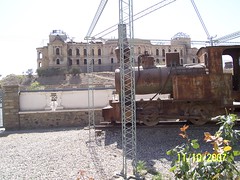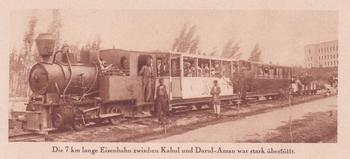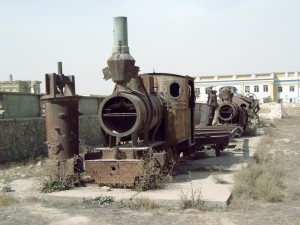Another picture of one of the steam locos in the Darulaman museum. It was actually made by Henschel in Germany, rather than in Britain.
Kabul
Photograph of the Kabul – Darulaman railway
Karlheinz Rohrwild has found this wonderful picture in the February 1930 issue of the German magazine “UHU”. The caption says The 7 km long railway between Kabul and Darul-Aman was very over-filled.
.
I guess the building in the background is the palace at Darulaman. Werner Müller has put on-line some fascinating old photos of Afghanistan and Darulaman taken by his ancestor Wilhem Rieck in the 1920s, which are well worth a browse, even if you can’t read German.
- I’ve got another page with some more pictures of the tramway.
The Kabul locos
Two photos of an Old loco in Afghanistan taken by Major Rob Fraser of the Oregon Army National Guard were posted on Trainorders on 6 December 2006 (thumbnails only – full pics requires a subscription). Accoring to the report, The builders plate says: Henschel & Sohn, G.m.b.H., Cassel, 1929, 12 ATM, Kessel No. 1968.
. The two locos previously in the shed have previously been reported as 19680 and 19681 of 1923, so this could be the mysterious third loco (and perhaps the last digit of the number has become illegible)?

 The May 2007 Rail Passion magazine article is broadly similar to this April 2006 article from NATO: German ISAF Personnel relocate historical railway engine. I’ve borrowed ISAF’s photos of the loco being moved, and from the un-bent cab it looks to be the one in Major Fraser’s photos (above). Other reports suggest that one of the three locos is actually 2′ gauge, rather than the 2’6″ of the other two engines, so all three are unlikely to have worked on the same line (if anyone happens to be passing Darulaman and has a tape measure, it would be interesting if the gauges could be confirmed). Quite where it did work is still a bit of mystery, as until recently all reports only mentioned two locos at the museum site.
The May 2007 Rail Passion magazine article is broadly similar to this April 2006 article from NATO: German ISAF Personnel relocate historical railway engine. I’ve borrowed ISAF’s photos of the loco being moved, and from the un-bent cab it looks to be the one in Major Fraser’s photos (above). Other reports suggest that one of the three locos is actually 2′ gauge, rather than the 2’6″ of the other two engines, so all three are unlikely to have worked on the same line (if anyone happens to be passing Darulaman and has a tape measure, it would be interesting if the gauges could be confirmed). Quite where it did work is still a bit of mystery, as until recently all reports only mentioned two locos at the museum site.
The locos can (just) be seen on this photo at Kabul guide.
Une vapeur Henschel
The May 2007 issue of French magazine Rail Passion (issue no.115, page 86) has a one-page article by Dimitri Beck about the plinthed steam locomotive at Kabul museum.
“Une vapeur Henschel devant le musée de Kaboul” has two photos, including a rather nice view showing German NATO soldiers putting one of the locos on a four-axle military lorry; moving the loco 200m to the museum for safe-keeping took about 3 hours.
There is a mention of Wim Brummelman, who sent me some photos of the three locomotives in the past.
Thanks to Thomas Kautzor for alerting me to it.
Light Railways magazine on Kabul line
I’ve just stumbled across a mention of a letter about the Kabul tramway in the April 2007 issue (no 194) of an Australian publication called Light Railways, which is produced by the Light Railway Research Society of Australia Inc. I’ve not seen a copy of this magazine – anyone know if it says anything interesting, and if it might be worth me ordering a copy?
Letters – […] Kabul tramway, Afghanistan
German ISAF Personnel relocate historical railway engine
Gag Halfrunt has spotted that NATO’s International Security Assistance Force website has an article dated 22 May 2006 about moving the steam loco. There are a couple of photos of the loco being moved, and three more in a PDF newsletter.
KABUL – Afghanistan. A joint venture between the Deutscher Entwicklungsdienst and the German Supply Company 2, has led to the staging of a major attraction at, or to be more precise, in front of, the Kabul National Museum. A major operation was conducted in order to assist soldiers from the recovery unit lift a historical locomotive from its resting place with the help of their crane and a heavy multi-purpose truck. The engine, which had been neglected in the museum’s backyard, is one of just three historical railway engines left in Afghanistan. Now, after 80 years, it has been granted a place of honour in front of the National Museum, directly opposite the Darulaman Palace.
For five years only, between 1923 and 1929, Afghanistan had its own railway. Three steam engines manufactured by Henschel, a German enterprise, travelled on a test track running from Kabul, southwest to the Darulaman Palace, located 7 km from Kabul, at that the time, the fare for a one-way ticket was one Afghani or 0.02 Euros. The project, however, was short-lived,
As long as Afghanistan does not have enough weapons to ward off acts of aggression by the big powers (British Empire and the Tsar) it would be crazy to allow the construction of a railroad track leading into his country, Emir Abdul Rahman (1880 – 1901) stated. Still today, Afghanistan remains one of the few countries in the world without a railroad system.The idea to put the best preserved locomotive on display in front of the museum’s entrance came from the Deutscher Entwicklungsdienst and with the help of the German supply company the 10-ton engine was moved 200 meters and placed on a track bed which had previously been raised by the recovery unit. In view of the considerable age of the engine, this procedure had to be executed with great care and the utmost precision by the crane specialists. Finally, after almost three hours of nail-biting work, First Lieutenant Boris Barchanski reported, “Locomotive in place, mission accomplished!”
Kabul steam loco photos
“DJK” has supplied three photos of the steam locos in Kabul, taken on July 2 2006. All three are still there, but one has been moved … more prominently on display. It was the first one in the line of three, and also in the best condition. It sits on a segment of track that is barely longer than the locomotive.
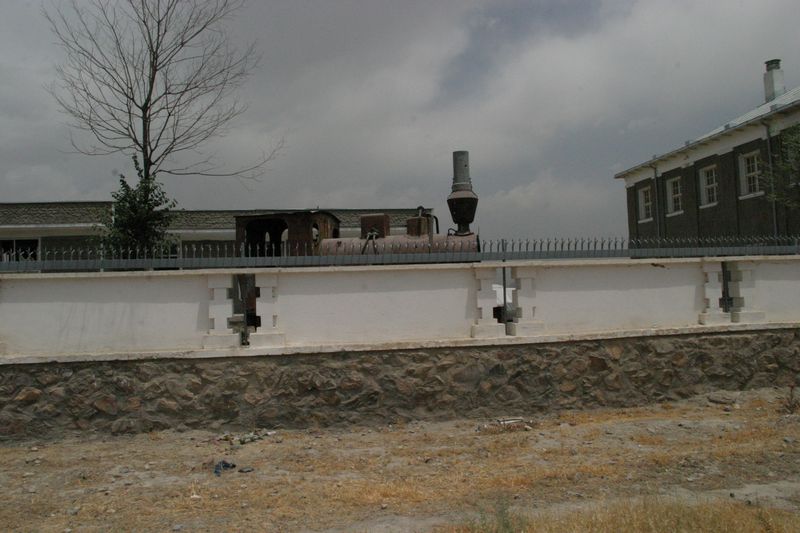
View over the wall
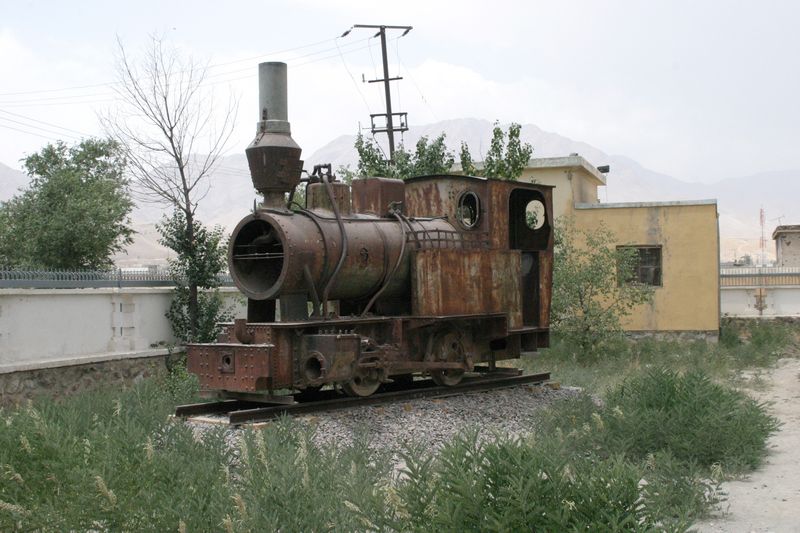
Loco on display
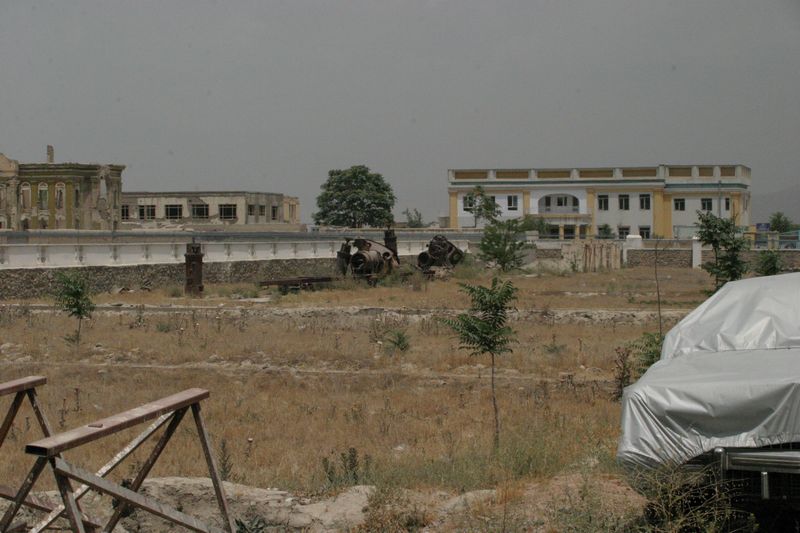
General view
Excitingly, I have been told by someone here that he has seen a number of locomotives at one of the hydroelectric power plants near Kabul city.
Trolley buses in Kabul
This Czech website has a map and illustrated history of Kabul’s trolleybuses. The photo of a Czech trolley bus and a camel is rather fun. There are more details on the Czech-language page.
